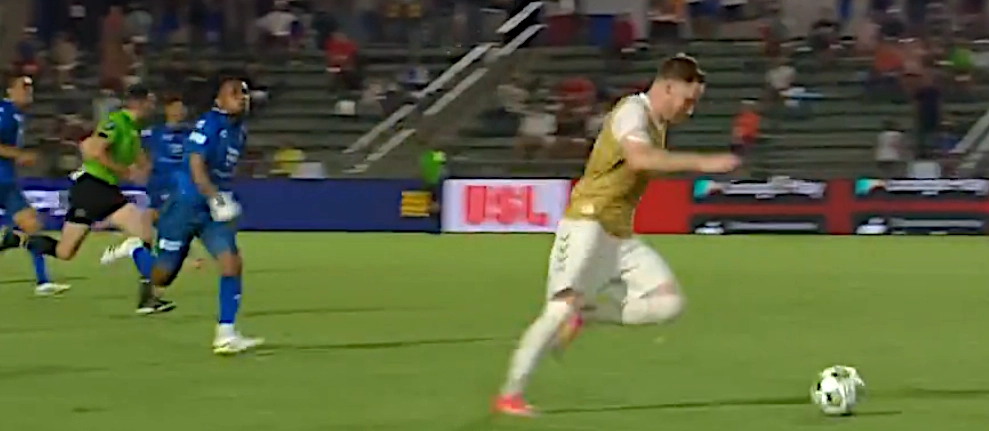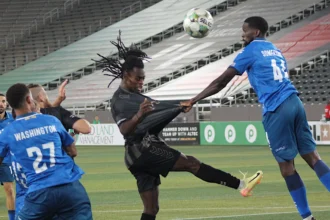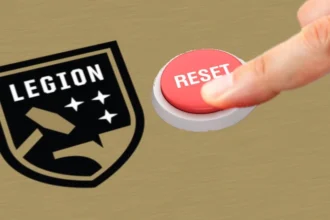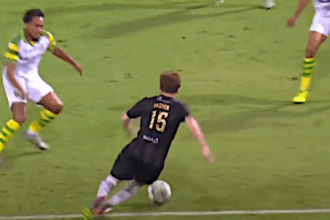My personal opinion on this game was that it was the best showing—two sloppy defensive errors notwithstanding—that the Legion has produced all season. Most notably, the team was playing in a way that reflects what Mark Briggs has been trying to instill since he got to the Magic City. Despite the score, Briggs himself was of a different mind. “I thought performances before the weekend were much better. You take the Rhode Island performance, you take the Indy Eleven performance but we never got the result. On Saturday the performance was decent. But we got the result and I think our front three were ruthless, which is where we need them to be.”
I can’t disagree with that last point. One thing that has largely been lacking for the Legion this season (and for most of last season too, frankly) is finishing the chances the team creates. In 17 league games in 2025 the team has exceeded its xG just 5 times (I can’t find xG numbers for the Jägermeister Cup games) and until last week by relatively thin margins. Against North Carolina the xG was a lowly 1.40 (per American Soccer Analysis), which means the Three Sparks outperformed the xG by a factor of 214.3%. Not bad at all. Further, the Legion has a cumulative xG of 21.92 and has scored 17 (not counting 2 own goals). That’s a factor of 77.6%. Before this weekend the conversion rate was even lower at 68.2% such that the team exceeded its previous season average by 3.14x.
The highest xG of the season to date was the Tampa Bay game which ended 2-2. The xG was 2.69, so the team underperformed on that one. Worse, the Legion had a total of 33 touches inside the Rowdies’ 18-yard box and racked up 12 shots inside the box. Frankly, the xG (and the score) should have been higher. And that leads to another point…
…touches inside the box should translate to more scoring opportunities. It did in Tampa but the conversion rate was low. In all 20 USL games the Legion has had 291 touches in the attacking 18, from which they have generated 126 shots (43.3%) and 21 goals (7.22%). That doesn’t sound great, and it isn’t. Overall, the Legion’s scoring, shooting and conversion rate in Championship play are all middle of the pack and need to improve.
Which is what happened last Friday and has to continue to happen going forward. Also important is how the Legion made those improvements against North Carolina. Regular readers will be aware that Mark Briggs is pushing heavily for better transitional play, in particular, faster transitional play. This contrasts strongly with Tommy Soehn’s approach which focused on slow build-up. And that would regularly result in getting stymied in the attacking third with opposing defenses having too much time to organize.
Fast transition seems to be the means to success in the Championship, certainly if last week’s results are anything to go by. As we noted in the Power Rankings, the weekend’s winning teams averaged just 44.7% possession. The Legion had a modest 41.9%. And the 3 possessions ending with the 3 goals were 6, 13 and 24 seconds respectively. A whopping 43 seconds in total. All of them were thus transitional in nature but of differing kinds. Let’s take a look at each of them.
First, Ronaldo Damus’ first-half equalizer:
This followed immediately from a shot attempted by Danny Trejo and the resulting goal kick. Because play was already deep in the North Carolina half, this set up a golden opportunity for a high press. As play restarted, only 5 players were in the Legion half: North Carolina striker Oalex Anderson, Legion keeper Fernando Delgado and his 3 center backs. This forced a short goal kick and allowed for some serious challenging by the Three Sparks, initially by Ronaldo himself. Ronaldo makes four challenges for the ball, moving from just above the center of the D all the way to the right edge of the 18 back to the left edge and then eventually back to the center to take the shot. He first presses Ahmad Al-Qaq (#19), then Paco Craig (#5), then Bryce Washington (#27) and finally keeper Jake McGuire (#1) who is way out of his box, a very dangerous decision given the overall positioning. Ronaldo hurries him into a bad pass which falls to Tyler Pasher’s feet. Tyler shoots it off Pedro Dolabella’s (#8) face. Enzo Martinez then wins the ball from McGuire again, setting up the eventual goal with McGuire still behind him. In the entire sequence the ball never makes it out of the North Carolina defensive third. Classic high pressing straight off the training field.
Next, Danny Trejo’s first goal:
Obviously, this starts from a set piece situation at the Legion end and is very similar to the goal scored by Sebastian Tregarthen at the end of the Sacramento Republic game a month ago. The situation is the direct opposite of Ronaldo’s goal: the majority of the players are crammed into the Legion box and only McGuire is in the North Carolina half. Michael Maldonado’s (#15) corner kick bounces around the Legion 18 until Patrick Burner (#11) finally gets a shot off. Moses Mensah clears it straight to Tyler and he is off to the races, tearing down Route 1. Watch the clip with the sound on and you will hear the commentator clearly state that there is a 4-on-2 situation. By that he means the Legion has 4 attackers against just two North Carolina defenders, not the other way around. As Tyler crosses into the North Carolina half he has Ronaldo ahead of him and both defenders (Washington and #14 Rafa Mentzingen) are covering him. That leaves both Danny and Enzo trailing Tyler to move at liberty. Ultimately Tyler’s passing choice is obvious and Danny does not disappoint.
From the beginning of Tyler’s run to the pass takes 10 seconds and the distance he covers, mostly with the ball at his feet, is a good 80 yards. Again, the commentator is spot on, noting that he can fly. No kidding.
Finally, Danny Trejo’s second goal:
This has similarities to Danny’s first goal in that it’s a fast end-to-end move but there are quite a few differences. The first is that it starts from open play. Duh. The second is that the Legion does not have a numerical advantage in the attacking half. As the ball crosses the half-way line, only Ronaldo is already there and he’s in a 1-on-2. Third, rather than a fast dribble, the sequence employs long passing. Fourth, it also uses the full width of the field, stretching the defense as much as possible.
As to using the entire width of the field, Ronaldo took that to the limit:
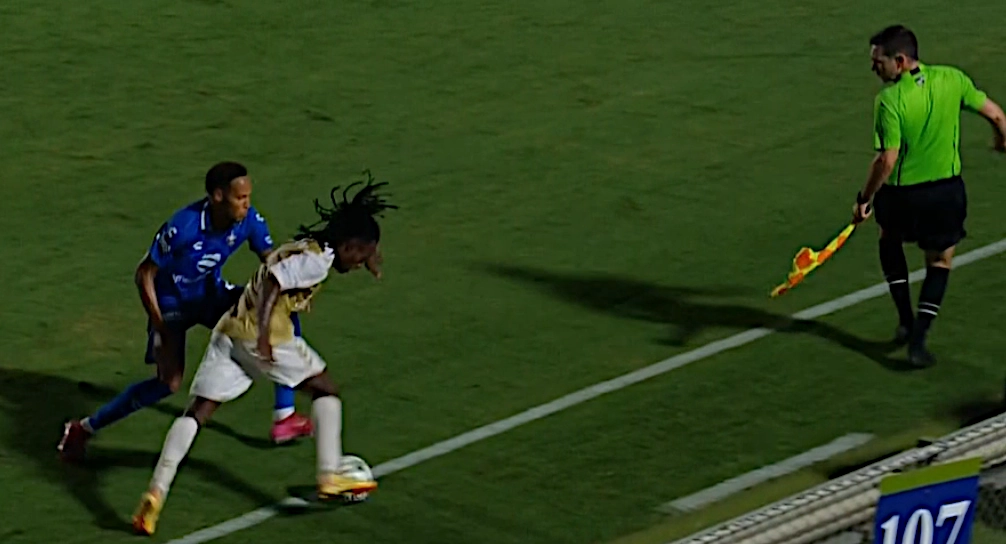
The ball is at least half over the touchline but he keeps it in play. Note that the AR is staying ahead of the play but is looking back as he does so. Consequently, he is able to make the correct no-call on a potential out-of-bounds. Both ARs were thus responsible for correct dead-ball calls on scoring situations, both favoring the Legion. The other was the somewhat bizarre late call at the Legion end in the first minute of second-half stoppage time when Evan Conway attempted to keep the ball in play. The entire Legion defense stopped playing (a no-no, to be honest) and the ball ended up in the net but was ultimately called out by the AR. Briggs’ comment on that was pretty clear: “If that goal would have stood, where the ball’s off the field, I would have got my second red card of my career.” Overall, the refereeing was questionable, especially the yellow cards and the excessive and extended stoppage time, but the AR calls were critical and totally correct.
Danny’s brace got the plaudits from the league, but Tyler was our Man of the Match. Briggs wholeheartedly agreed. “Since I’ve come into the club Tyler Pasher’s been exceptional. Every game, every game, he’s shown something every game. He’s worked his ass off. And I think, if you look at the last play of the game on Saturday [it was Friday!], and I showed the guys this. The very last play of the game right before the whistle blows…Tyler Pasher is sprinting from the right side of the field to the left side of the field, back to the other center back, back to the left back. He drags Preston with him and they don’t get a ball forward because of the work rate of those two.”
Not only that, but he was also directing other players as he did it. Total commitment. So, to finish up, here’s what Briggs was referring to:
